Bisotun, located in the city of Kermanshah, is a very famous complex that is considered a fascinating attraction for everyone. It houses numerous historical artifacts such as the Statue of Hercules, Bisotun Bridge, Shah Abbasi Caravanserai, the prominent bas-relief of Darius the Great, the Farhad Tarash sculpture, and many others that captivate the attention of all visitors. For this reason, it is considered one of the important archaeological sites in Iran. One of the significant archaeological treasures in this complex is the stone inscription and bas-relief of Darius, which is registered as a UNESCO World Heritage Site. Furthermore, the numerous caves in the Bisotun mountains bear witness to human presence in this area during the Paleolithic period. Due to its historical significance, with artifacts dating back approximately four thousand years ago, Bisotun is regarded as a treasure trove of Iranian history. To date, 28 of its artifacts have been registered as national treasures of Iran. In this article from Eligasht, we will explore the fascinating details of the Bisotun Complex, unveiling its rich history and cultural importance.
The introduction of Bisotun
Bisotun is a historical and cultural site that ranks among the must-see places in Kermanshah. It was included in Iran’s National Heritage List in 2002, and the Darius the Great Inscription and Rock Relief at Bisotun were added to the UNESCO World Heritage List in 2006. However, the value and importance of Bisotun can be traced back to the Paleolithic period, and research on this area can be continued, especially considering that the caves and rock shelters in Bisotun demonstrate its significance as one of the most important settlements in the Zagros mountain range.
The Bisotun complex covers an area of 1,650 hectares and boasts a rich historical, natural, and environmental diversity. However, what has brought Bisotun international fame and its inclusion in the national heritage is the inscription of Darius the Great, dating back to 520 BCE.
The Bisotun mountain complex has housed 28 registered national treasures, including the Shekarchiyan Cave, Mar Dudar Cave, Sarab-e Bisotun, Mar Tarik Cave, Maadi Sanctuary, Balash Stone, the bas-relief of Mehrdad Ashkanian, the bas-relief of Gudarz, Farhad Tarash, Ilkhanid Caravanserai, Bisotun Bridge, and many other valuable artifacts. These unique and precious artifacts are important historical records of Iran.
this may be interesting for you to know that in the vicinity of Mount Bisotun, there are scattered pieces of carved limestone rocks in the shapes of rectangular and cubic blocks. Similar stone pieces can also be seen in the semi-finished structures of the Sasanian era, such as the Farhad Tarash and Khosrow Bridge. In addition to the carving technique used in these blocks, the symbols of masons in these two arts are also in the style of the Sasanian period.
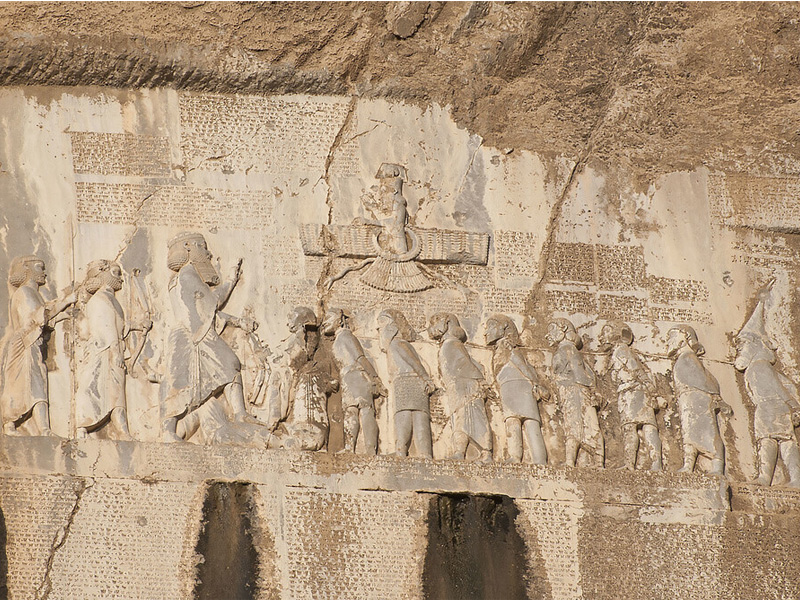
An overview of the geographical location of Mount Bisotun
Mount Bisotun is located 30 kilometers northeast of Kermanshah, alongside the ancient and historical road from Kermanshah to Hamadan. This historical site in the foothills of Mount Bisotun shines like a brilliant gem in the city of Bisotun, captivating all who behold it.
A glimpse into the history of Mount Bisotun in Kermanshah, a symbol of love and loyalty
The Bisotun complex is considered one of the most significant historical sites in the country, attracting the attention of ancient kings and rulers for various reasons. Among the reasons that should be mentioned is the pleasant and appealing climate of Mount Bisotun, as well as its excellent geographical location. Furthermore, Bisotun was near the region of Mesopotamia. It’s interesting to note that the Bisotun plain was located near important connecting roads, such as the road from Media to Babylonia and the Silk Road, which have been of great importance to rulers and governments throughout history. This itself indicates the primary reason for the attention of various dynasties’ kings to this region. As Mount Bisotun was situated on the route of caravans and military movements, it served as a strategic area for the kings of Iran, symbolizing their power.
This historical and ancient site contains artifacts from various periods, ranging from prehistoric times to the Islamic era. The Shekarchiyan Cave and Markherl Cave belong to the prehistoric period, the Maad Temple from the Median period, the Bisotun inscription and relief from the Achaemenid period, the Hercules Statue from the Seleucid period, the Balash Stone, the Gudarz Stone Relief, and the Mehrdad Ashkanid Relief from the Parthian period, the Bisotun Palace, the Farhad Tarash, the Sasanian buildings, and the Sasanian Bridge (Khosrow) from the Sassanian period, the Ilkhanid Caravanserai from the Ilkhanid period, the Shah Abbasi Caravanserai, the Sheikh Ali Khan Zanganeh Inscription, and the Bisotun Bridge (Safavid Bridge) from the Safavid period.
A historical writer named Hassan Pirnia wrote in his book “Ancient History of Iran” about the description and explanation of Bisotun:
Bisotun is a mountain that reaches a height of four thousand feet, and springs flow out of it at its base.
From ancient times, caravans used to stop here.
Ibn Hawqal, a Muslim geographer of the 4th century AH, said:
Bisotun is a tall mountain that cannot be reached at its peak, and the pilgrims’ route passes underneath it from Nishapur to Helwan.
Related post
Exploring Shiraz National Garden: A Captivating Oasis of Beauty and History
Introduction to 20 Famous Four-Iwans in Iran (Chahartaqi)
What is the reason for naming this mountain Bisotun?
Bisotun comes from the word “Baghestan,” which means the abode of gods, and its ancient name was likely Bagastana. Over time, the name changed to “Bahistan” and later “Bahistun.” After the arrival of Islam to this land, it was called “Beh sotun,” which means a good column or a better column. Today, it is still called Bisotun, and reading it as “Bi-stun,” which means without a column, is incorrect and has no validity.
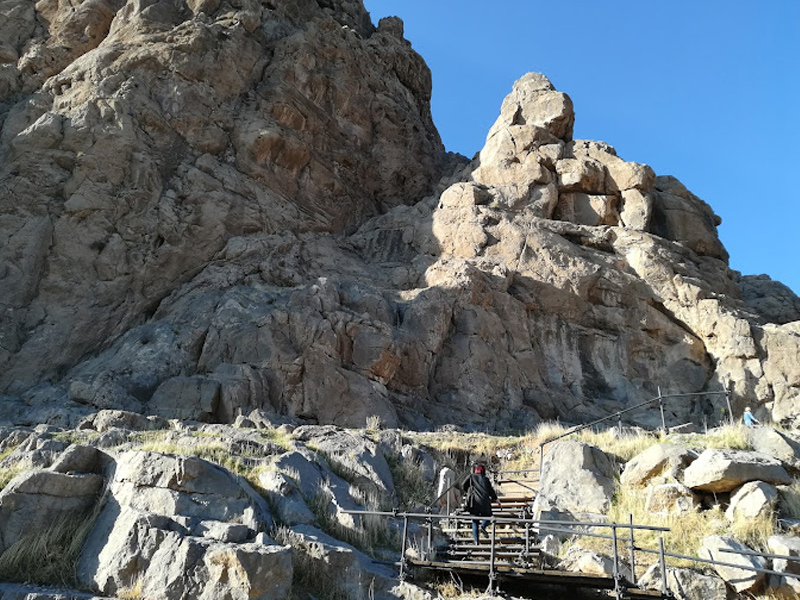
Bisotun Mountain
There are numerous historical monuments in the Bisotun complex.
The historical monuments around Bisotun are as follows:
– Maad Niyashgah from the Median period
– Markherl Cave and Shekarchiyan Cave from the prehistoric period
– Bisotun relief and inscription from the Achaemenid period
– Sang-e Balash
– Bisotun Palace
– Heracles Statue from the Seleucid period
– Gudarz Stone, Mehrdad’s Relief from the Parthian period
– Sasanian Bridge and Sasanian structure from the Sasanian period
– Farhad Tarash
– Sang-e Balash
– Ilkhanid Caravanserai from the Ilkhanid period
– Shah Abbas Caravanserai
– Sheikh Ali Khan Zanganeh Inscription
– Bisotun Bridge (Safavid Bridge) from the Safavid period
Each of these contains historical and literary works that have been left as a heritage for Iran. In this article, we intend to provide explanations about some of them.
The Bisotun Inscription
The Bisotun inscription, which is the most important and largest inscription in the world, is located in the Bisotun historical complex. This stone inscription is the first known artifact from the Achaemenid era in Iran and is carved into the side of the Bisotun mountain. The inscription describes the victory of Darius the Great over “Gaumata the Magus” and depicts the binding of rebels.
Near this inscription, there are traces of staircases, indicating that stone carvers built these stairs to access the inscription, and after completing their work, they removed the stone staircases to prevent anyone from accessing the inscription.
It seems that the audience of this stone inscription, which was made by the order of Darius the Great, the famous king of Iran, are future generations. The Bisotun stone inscription is written in three ancient languages: Old Persian, Elamite, and Babylonian, and it is inscribed in cuneiform script. Its dimensions are 7.8 meters wide and 22 meters long.
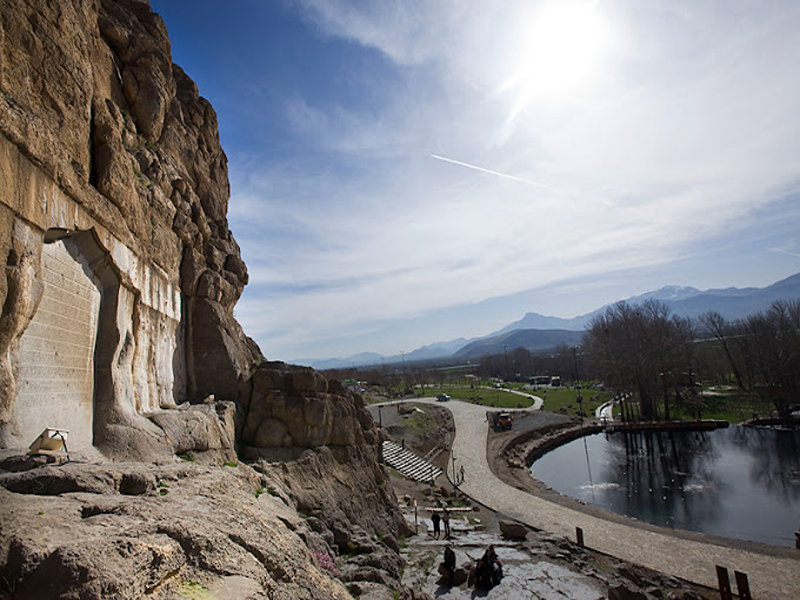
Prominent Relief in the Bisotun Complex
The Bisotun Relief is a stone sculpture with dimensions of 6 meters in length and 3.20 meters in width. This relief depicts the story of the victory of Darius the Great over the Magian usurper Gaumata and the capture of the rebels. Above the heads of the captives, there is an image of Ahura Mazda, who is presenting the ring of power to Darius the Great.
In addition, you can see Darius the Great in the image, placing his left foot on the chest of Gaumata, who has fallen beneath his feet. Darius is wearing a long robe and a crown on his head. He raises his right hand in the worship of Ahura Mazda, reaching upward. The image of Ahura Mazda is also depicted facing Darius, with the ring held in his left hand. He, too, raises his right hand, offering a gesture of benevolent prayer for Darius. Nine captives are also portrayed in this relief, standing in a row with their hands tied and ropes around their necks, facing Darius.
Hercules Statue in the Bisotun Complex
Another notable site in the historical Bisotun complex in Kermanshah is the statue of Hercules, dating back to the Seleucid period. This historical artifact was discovered in Bahman 1337 SH (February 1959) while laborers were excavating for the construction of the Hamadan-Kermanshah road. The statue of Hercules dates back to 153 BCE, during the reign of Meherdad I of the Arsacid dynasty and the late Seleucid rule.
In this historical statue, Hercules, a muscular figure, is portrayed reclining on the left side, under the shade of a tall tree, with a lion’s skin beneath him. He holds a cup of wine in his right hand, and his left-hand rests on his right leg.
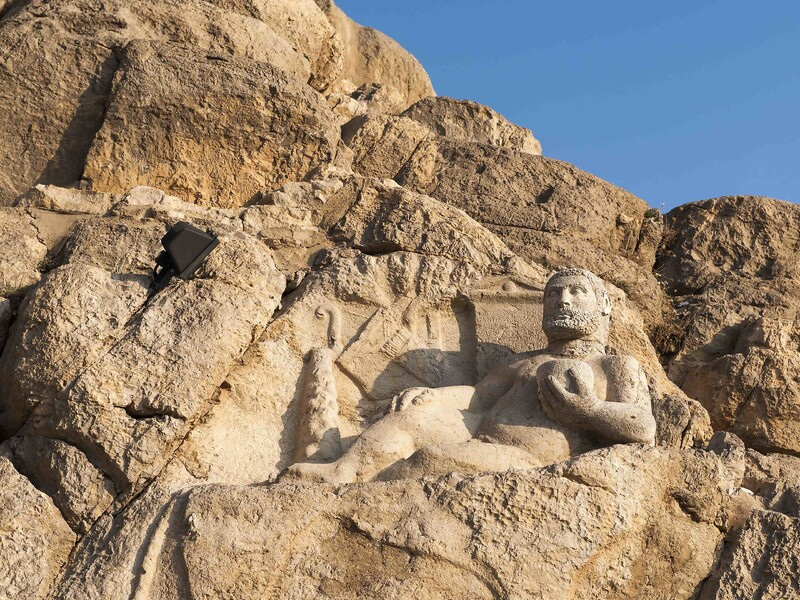
Bisotun Pond
Bisotun Pond is a spring that gushes from the heart of the earth, collecting its water in a pool within the Bisotun historical complex in Kermanshah. It adds to the beauty of this area. This pond was one of the significant factors for human settlement during the Paleolithic period in this region.
Niyayeshgah-e Madi (Median Temple) in the Bisotun Complex
The Niyayeshgah-e Madi (Median Temple) is located beneath the Bisotun inscription. This temple is a carved stone panel with dimensions of 10.5 x 7 x 1.5 meters and is made of unfinished stone. The temple is divided into two sections by a 7-meter-long corridor. At the end of the corridor, there is a room surrounded by a mountain cleft and a wall. In excavations conducted by a German expedition 60 years ago, pottery dating back to the early 1st millennium BCE was discovered in this area.
Goudarz Stone Relief from the Parthian Period in the Bisotun Complex
The Goudarz Stone Relief is another notable historical artifact in the Bisotun complex, which was registered as a national heritage site in 2001. This stone relief is a relic from the Parthian period and beautifully depicts the victory of Goudarz II over Mehrdad. The Goudarz Stone Relief does not have a clear image. In this historical artwork, you can see three armored warriors, with the central figure being Goudarz, the Iranian king.
Mehrdad Ashkanid Relief from the Ashkanid Period
The Mehrdad Ashkanid Relief is one of the oldest surviving artifacts from the Ashkanid period in the Bisotun historical complex. It holds great archaeological value and dates back approximately 123 to 110 years BCE.
Shah Abbas Caravanserai
The Shah Abbas Caravanserai is another fascinating site in the Bisotun historical complex in Kermanshah. Its construction began by the order of Shah Abbas Safavid. This unique historical structure in the Bisotun Mountains was registered as a national heritage site in 1974. The Shah Abbas Caravanserai covers an area of 6,000 square meters and is built in the style of Safavid caravanserais.
During the reign of Naser al-Din Shah, this caravanserai was restored and renovated, and during the Pahlavi era, it was used as a grain warehouse. After the victory of the Islamic Revolution, it served as a prison for 17 years until it was purchased by the Cultural Heritage Organization. It is now used as a traditional 5-star hotel.
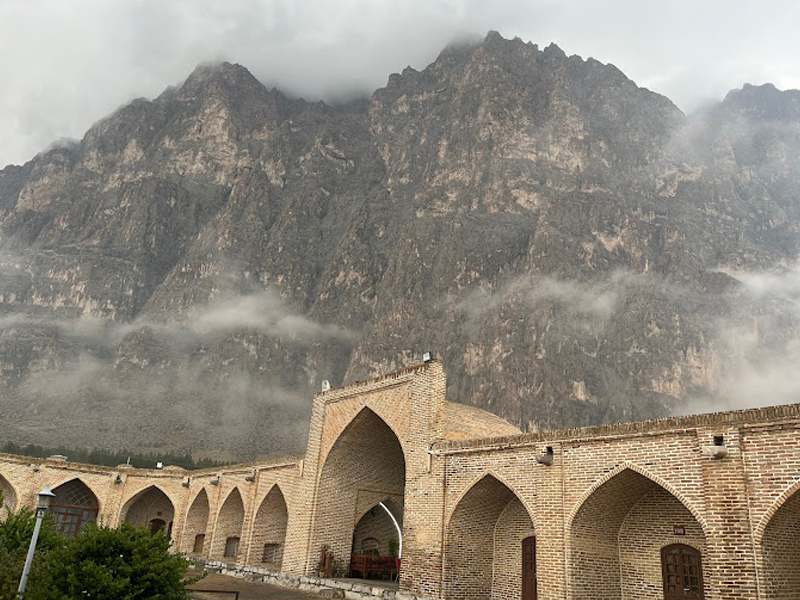
Bisotun Palace
Bisotun Palace is a semi-constructed palace from the Sasanian period located in the historical Bisotun complex in Kermanshah. This palace has been the subject of extensive research since 1976. It was originally intended to be a palace during the Sasanian era but, for unknown reasons, remained unfinished and later transformed into a caravanserai. The caravanserai that was built was destroyed by an earthquake, and a village was constructed in its place during the Qajar period.
Farhad Tarash (Farhad Quarry)
Farhad Tarash, also known as Farhad Tash, Faratash, or Faray Tash, is a large rock wall measuring 45 meters in height and 200 meters in width that dates back to the Sasanian period and has been carved. This site, named after Farhad, the mountain carver who was a legendary figure in Persian literature, is one of the notable attractions in the Bisotun historical complex. It was registered as a national heritage site in 2001 and has added to the significance of the Bisotun complex from a historical perspective.
Shekarchian Cave (Hunters’ Cave)
Shekarchian Cave is located above the Hercules statue and was a temporary refuge for hunters. It was used for hunting and hiding from animals during the hunting expeditions. The Shekarchian Cave, dating back to the Paleolithic period, was registered as a national heritage site in 2001, further enhancing the historical importance of the Bisotun complex. In the cave, hunting tools and animal bones such as ibex, deer, wild horse, wild cow, and gazelle, as well as a human ulna bone dating back 40,000 to 70,000 years, belonging to the Neanderthal humans, have been discovered.
Markher Cave
Markher Cave is another cave in the Bisotun historical complex, characterized by its circular entrance. Thick and carved stone blades from the Paleolithic period have been discovered in this cave. However, the artifacts in Markher Cave are not limited to the Paleolithic period, as there are also artifacts from the Sasanian era found in this area.
Visitor Information and Conditions
Visiting hours for the Bisotun site: 8 am to 8 pm
Contact number: +98 831 342 18891, +98 831 342 18892

Final words
The Bisotun historical complex is one of the most prominent historical sites in the world. If you haven’t had the opportunity to visit this historical site and its renowned artifacts in Kermanshah, we recommend including a visit in your plans. The inscription in this complex is one of our country’s world heritage sites. All the mentioned details emphasize the need for better care and preservation of this historical complex. It is hoped that the authorities and visitors, understanding the significance of this ancient site, will strive to preserve it for future generations, as Darius the Great desired in his inscription.
FAQ
1- What is the Bisotun complex?
The Bisotun complex is a UNESCO World Heritage Site located in western Iran. It encompasses a vast area that includes the Bisotun Mountain, a historical rock relief, ancient inscriptions, and archaeological remains. The complex holds significant historical and cultural importance.
2- What is the historical significance of the Bisotun complex?
The Bisotun complex is historically significant as it contains a rock relief and inscriptions dating back to the Achaemenid Empire, specifically from the reign of King Darius the Great. These inscriptions provide valuable information about ancient Persian history, including the rise of Darius and his conquests.
3- How do I reach the Bisotun complex?
The Bisotun complex is located near the city of Kermanshah in western Iran. It is easily accessible by road, approximately 30 kilometers from Kermanshah. Visitors can hire a taxi or use private transportation to reach the site. Local tour operators also offer guided tours to the Bisotun complex.

